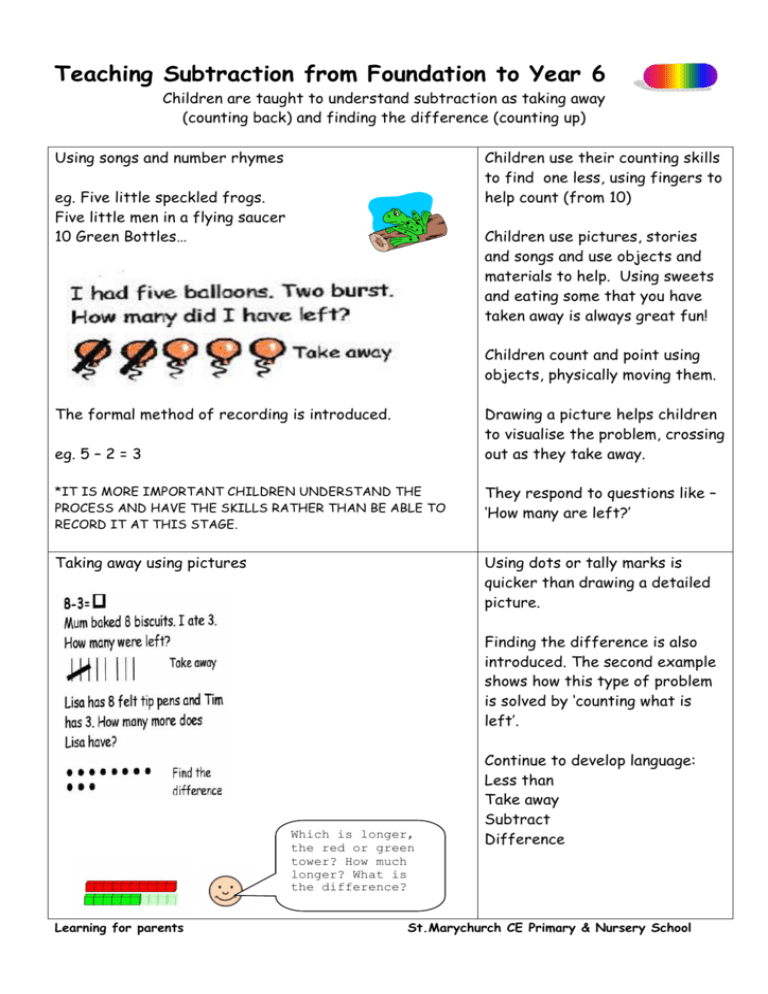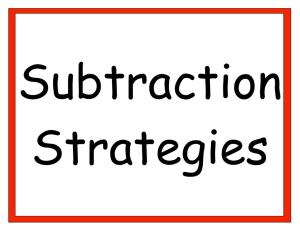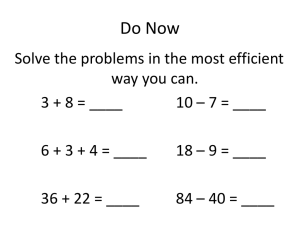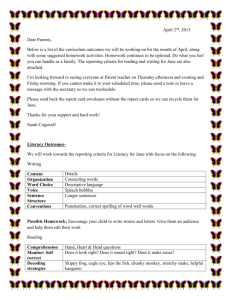Teaching Subtraction
advertisement

Teaching Subtraction from Foundation to Year 6 Children are taught to understand subtraction as taking away (counting back) and finding the difference (counting up) Using songs and number rhymes Children use their counting skills to find one less, using fingers to help count (from 10) eg. Five little speckled frogs. Five little men in a flying saucer 10 Green Bottles… Children use pictures, stories and songs and use objects and materials to help. Using sweets and eating some that you have taken away is always great fun! Children count and point using objects, physically moving them. The formal method of recording is introduced. Drawing a picture helps children to visualise the problem, crossing out as they take away. eg. 5 – 2 = 3 *IT IS MORE IMPORTANT CHILDREN UNDERSTAND THE PROCESS AND HAVE THE SKILLS RATHER THAN BE ABLE TO RECORD IT AT THIS STAGE. They respond to questions like – ‘How many are left?’ Taking away using pictures Using dots or tally marks is quicker than drawing a detailed picture. Finding the difference is also introduced. The second example shows how this type of problem is solved by ‘counting what is left’. Which is longer, the red or green tower? How much longer? What is the difference? Learning for parents Continue to develop language: Less than Take away Subtract Difference St.Marychurch CE Primary & Nursery School Introducing subtraction with number lines 11 - 7 = Children start using a number line including making their own to subtract in ones. 11 take away 7 is Starting at the largest number and counting back is a successful way of solving ‘Taking away’ Start on 11 and count back 7 spaces. What is the difference between 11 and 7? Start on the smallest number and count on until you get to the larger number. How many ‘jumps of one’ has it taken? 10 - = 4 -6=4 Children may initially use their fingers to help with this process but they do not need to be reliant on them. If 7 + 2 = 9, what else do you know? 2 + 7 = 9 9 - 2 = 7 Learning for parents This question is about finding the difference. Children may solve it in the same way as just described however counting on from smaller number to bigger number is also very successful. Children are aware that subtraction is inverse(opposite) of addition Children use their knowledge of pairs of numbers that make 10 or 20 to find missing numbers. The children consider what facts they know using 3 numbers. St.Marychurch CE Primary & Nursery School Children become confident in counting forward to find the difference and back to take away in 10s from any number. 47-11 = 36 They identify patterns on hundred squares to help subtract 10s and 1s. In this example to solve 47 – 11, they understand that 10 is taken away (moving up a row in the 100 square) and then 1 is taken away (moving one space left). Partitioning Using TENS and ONES (UNITS) 23 – 12 = Most children start subtracting using partitioning. This can be done using 10 sticks (TENS) and 1s (ONES). Here you can see 12 is removed (1 TEN and 2 ONES), leaving 11 behind. So 23 - 12 = 11. 47 – 11 = 22 – 7 = Number lines are still used however it is now easier to take larger jumps (eg. in 10s). In this example 11 has been taken away by subtracting 10 and then 1. 47 – 10 -1 = 36 22 – 2 – 5 = 15 16 – 9 = 16 – 10 + 1 = 7 Learning for parents St.Marychurch CE Primary & Nursery School 61-23 = -3 Children who are confident taking away 10s and 1s start to chunk (count back in larger groups, eg. 20) when taking away on a number line. -20 Alternatively the question could be looked at as find the difference between 61 and 23. To solve this just count on from the smaller number until you get to the bigger number to find the difference. 84 – 56 = Taking away too much (compensating) 84 – 56 = 84 – 60 + 4 = 28 Children may take or count on to nearest 10. The number line is a secure way of recording their steps of subtraction. They will also start thinking about compensating. (Take too much and add back) Example: If you had 39 – 19 = 39 – 20 = 19 Then add 1 back on Counting up (complementary addition) The number line will continue to THIS IS THE SCHOOLS PREFERRED/MAIN METHOD be the most important tool to support and develop recording of £8.95 - £4.38 written subtraction calculations. They will continue to need to use number line alongside informal written methods. Here you can see how counting up is used to find the difference between two sums of money. Children will need secure understanding of pairs of numbers that make 100. The children will use number lines for decimals using either counting up or compensation. Learning for parents St.Marychurch CE Primary & Nursery School This method would then move on to look like this: If I add this 327 149 1 (150) 50 (200) 100 (300) 27 (327) It is important that the children understand that the decimal points line up with each other. I get to this total Until they reach the highest number.. Then add up all the steps taken… 178 Compensation (take too much, add back) £7.50 – £2.84 Recommended list of useful resources to have at home: Below are a list of things which would be useful to have at home to help your child in maths: All of these things can be made/drawn. • • • • • A 100 square Number bond cards – Cards which show the pairs of numbers which go together e.g. 1 + 9, 2 + 8, 3 + 7, 7 + 3 etc, for all the numbers which add to ten. You might then do 10 – 1, 10 – 2 etc for all the subtraction facts. Addition and subtraction facts could be learnt/made for all the numbers to 20. Digit cards - Small cards with 0 – 9 on them. ( Digit just means number but a number such as 234 is made up of 3 digits) Children can show you how to make numbers e.g. show me 23, show me one less than 47, show me 10 more than 39 etc. Multiplication grid. Objects for counting and sorting – buttons, beads, dried pasta etc. If you are unsure with these resources just ask your class teacher. Learning for parents St.Marychurch CE Primary & Nursery School





